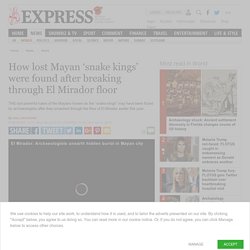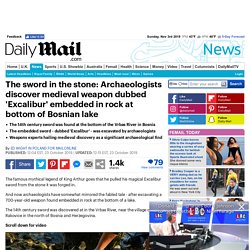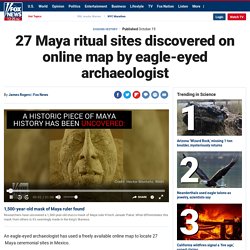

Archeology news: Ancient US burial site accidentally unearthed by baffled builders. 7000-year-old Native American burial site discovered in Florida Workers said they were digging alongside a part of the 405 Freeway in Westwood, California, when they came across the remains of what appeared to be a mass burial site.

Some of the items included in the excavated site include bones, with the location yet to be disclosed. According to Eric Carpenter of the Orange County Transit Authority (OCTA), agency officials are prohibited by law from providing a location or description of a grave or sacred places. The case was passed to the California Native American Heritage Commission, which is currently trying to fin out which tribe the remains might belong to.
Mr Carpenter said: “OCTA and its partners recognise the cultural sensitivity of the issue and will work with all parties involved to ensure appropriate and respectful procedures are followed. “It’s unclear at this point what effect, if any, it will have on the construction schedule or cost.” “But society moves forward.” Archaeology news: Mayan ‘snake kings’ were found after breaking through El Mirador floor. The Mayans were a civilisation known for their architecture, mathematics and astronomical beliefs who date back to as far as 2000BC.

With many of their impressive constructions still standing in the jungles of southeastern Mexico, Guatemala, Belize and western parts of Honduras. The site of El Mirador has encapsulated researchers over the years, including Richard Hansen, who uncovered ruins that led him to believe this area of Guatemala may have been home to the snake kings. This lost empire is rumoured to have created the most powerful alliance in their culture's history – the snakes – who experts believe moved from place to place, creating megacities and implementing the strictest of regimes, yet their bodies have not been uncovered. Archaeologist Josh Gates visited El Mirador earlier this year before creating the “Expedition Unknown” documentary for Discovery UK. Archaeologists find medieval 'Excalibur' sword in Bosnian lake. The sword in the stone: Archaeologists discover medieval weapon dubbed 'Excalibur' embedded in rock at bottom of Bosnian lake The 14th century sword was found at the bottom of the Vrbas River in BosniaThe embedded sword - dubbed 'Excalibur' - was excavated by archaeologists Weapons experts hailing medieval discovery as a significant archaeological find By Ed Wight In Poland For Mailonline Published: 12:04 EST, 23 October 2019 | Updated: 12:15 EST, 23 October 2019.

Archaeologists in Jerusalem Dug Up a Road Built by Pontius Pilate. An archaeological excavation begun 125 years ago has wrapped up with a fascinating discovery: A Roman-era street connecting two religious destinations in Jerusalem was likely built by Pontius Pilate.

Researchers were able to date the 720 feet of uncovered road to about A.D. 30, thanks to coins found along the pavement. That lines up with the governorship of Pontius Pilate, a prominent figure in the Bible. If Pilate commissioned this ornate road, he spent more time building public infrastructure than historians previously gave him credit for, the authors explain in a paper published in Tel Aviv: Journal of the Institute of Archaeology. Walking in Ancient Footsteps This ancient walkway began at the city’s southernmost gate and connects two monuments with special significance to Jews and Christians: the Pool of Siloam and the Temple Mount. Previously, streets of this importance and grandeur were only thought to have been built in an earlier Roman era, the study authors write via email. 27 Maya ritual sites discovered on online map by eagle-eyed archaeologist. 1,500-year-old mask of Maya ruler found Researchers have uncovered a 1,500-year-old stucco mask of Maya ruler K'inich Janaab 'Pakal.

What differentiates this mask from others is it’s seemingly made in the king’s likeness. An eagle-eyed archaeologist has used a freely available online map to locate 27 Maya ceremonial sites in Mexico. Takeshi Inomata, a professor of archaeology at the University of Arizona, made the discovery using a LiDAR (Light Detection and Ranging) map he found online last year, according to the New York Times. LiDAR technology harnesses a laser to measure distances to the Earth’s surface and can prove extremely valuable to study what is hidden in areas with thick vegetation. The 2011 map, which covers 4,400 square miles of the Mexican states of Tabasco and Chiapas, was published by Mexico’s National Institute of Statistics and Geography, the Times reported. Mayan mystery: How archaeologists uncovered secret 'passage to the underworld' in Mexico.
The Pyramid of the Moon is the second-largest in Mexico, behind the Pyramid of the Sun.

Dating back to as far as 100AD, the structure is located at the end of the Avenue of the Dead, in modern-day San Juan Teotihuacan, a place used for performing ritual sacrifices of animals and humans by the Mayans. After building on investigations lasting more than 300 years, archaeologists discovered a hidden tunnel that leads to a 15-metre-across chamber deep in the heart of the structure. Researchers believe this mysterious cavity might have been a funeral space, acting as a “passage to the underworld”.
The discovery was announced by archaeologists from Mexico’s National Institute of Anthropology and History (INAH) working in collaboration with geophysicists from the National Autonomous University of Mexico, at the Archaeological Zone of Teotihuacan around 25 miles northeast of Mexico City. “So it is not difficult to think that something similar could be found underground.